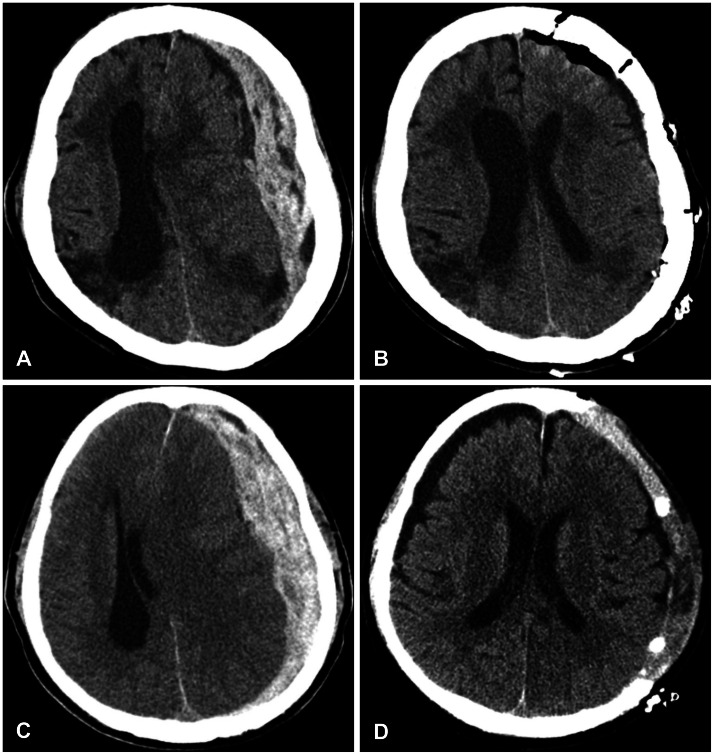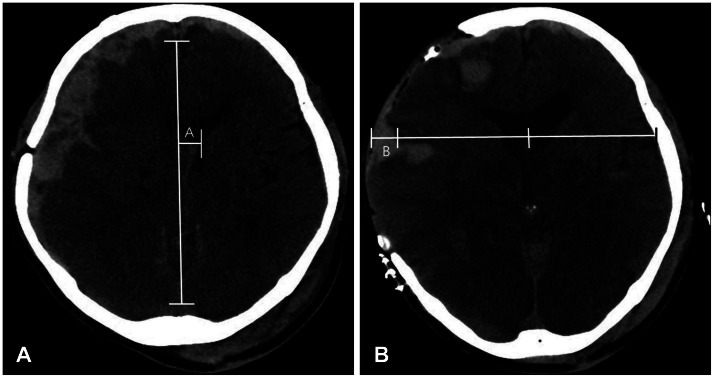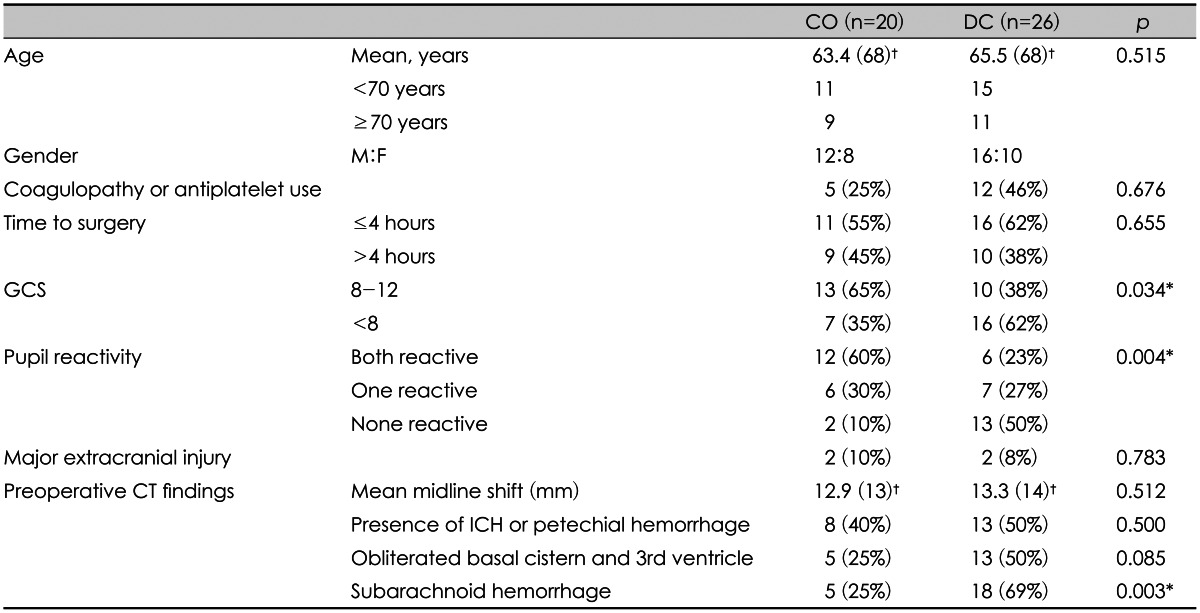1. Bullock MR, Chesnut R, Ghajar J, Gordon D, Hartl R, Newell DW, et al. Surgical management of acute subdural hematomas. Neurosurgery. 2006; 58(3 Suppl):S16–S24. discussion Si-SivPMID:
16710968.

2. Chaturvedi J, Botta R, Prabhuraj AR, Shukla D, Bhat DI, Devi BI. Complications of cranioplasty after decompressive craniectomy for traumatic brain injury. Br J Neurosurg. 2016; 30:264–268. PMID:
26083136.

3. Chen SH, Chen Y, Fang WK, Huang DW, Huang KC, Tseng SH. Comparison of craniotomy and decompressive craniectomy in severely head-injured patients with acute subdural hematoma. J Trauma. 2011; 71:1632–1636. PMID:
22027888.

4. Chibbaro S, Marsella M, Romano A, Ippolito S, Benericetti E. Combined internal uncusectomy and decompressive craniectomy for the treatment of severe closed head injury: experience with 80 cases. J Neurosurg. 2008; 108:74–79. PMID:
18173313.

5. Coplin WM, Cullen NK, Policherla PN, Vinas FC, Wilseck JM, Zafonte RD, et al. Safety and feasibility of craniectomy with duraplasty as the initial surgical intervention for severe traumatic brain injury. J Trauma. 2001; 50:1050–1059. PMID:
11426120.

6. Girotto D, Ledić D, Bajek G, Jerković R, Dragicević S. Efficancy of decompressive craniectomy in treatment of severe brain injury at the Rijeka University Hospital Centre. Coll Antropol. 2011; 35:255–258. PMID:
22220447.
7. Girotto D, Ledić D, Daji V, Vujković Z, Mihelcić N. Neurosurgical procedure for treatment of traumatic subdural hematoma with severe brain injury: a single center matched-pair analysis. Coll Antropol. 2014; 38:1255–1258. PMID:
25842771.
8. Godlewski B, Pawelczyk A, Pawelczyk T, Ceranowicz K, Wojdyn M, Radek M. Retrospective analysis of operative treatment of a series of 100 patients with subdural hematoma. Neurol Med Chir(Tokyo). 2013; 53:26–33. PMID:
23358166.

9. Gooch MR, Gin GE, Kenning TJ, German JW. Complications of cranioplasty following decompressive craniectomy: analysis of 62 cases. Neurosurg Focus. 2009; 26:E9. PMID:
19485722.

10. Honeybul S. Complications of decompressive craniectomy for head injury. J Clin Neurosci. 2010; 17:430–435. PMID:
20181482.

11. Honeybul S, Ho KM. Decompressive craniectomy for severe traumatic brain injury: the relationship between surgical complications and the prediction of an unfavourable outcome. Injury. 2014; 45:1332–1339. PMID:
24704150.

12. Huang AP, Tu YK, Tsai YH, Chen YS, Hong WC, Yang CC, et al. Decompressive craniectomy as the primary surgical intervention for hemorrhagic contusion. J Neurotrauma. 2008; 25:1347–1354. PMID:
19061378.

13. Kalayci M, Aktunç E, Gül S, Hanci V, Edebali N, Cagavi F, et al. Decompressive craniectomy for acute subdural haematoma: an overview of current prognostic factors and a discussion about some novel prognostic parametres. J Pak Med Assoc. 2013; 63:38–49. PMID:
23865130.
14. Karibe H, Hayashi T, Hirano T, Kameyama M, Nakagawa A, Tominaga T. Surgical management of traumatic acute subdural hematoma in adults: a review. Neurol Med Chir (Tokyo). 2014; 54:887–894. PMID:
25367584.

15. Li LM, Kolias AG, Guilfoyle MR, Timofeev I, Corteen EA, Pickard JD, et al. Outcome following evacuation of acute subdural haematomas: a comparison of craniotomy with decompressive craniectomy. Acta Neurochir (Wien). 2012; 154:1555–1561. PMID:
22752713.

16. Liang ES, Tipper G, Hunt L, Gan PY. Cranioplasty outcomes and associated complications: a single-centre observational study. Br J Neurosurg. 2016; 30:122–127. PMID:
26328774.

17. Meier U, Gräwe A. The importance of decompressive craniectomy for the management of severe head injuries. Acta Neurochir. 2003; 86(Suppl 86):367–371.

18. Ransohoff J, Benjamin MV, Gage EL Jr, Epstein F. Hemicraniectomy in the management of acute subdural hematoma. J Neurosurg. 1971; 34:70–76. PMID:
5539647.

19. Servadei F. Prognostic factors in severely head injured adult patients with acute subdural haematoma's. Acta Neurochir (Wien). 1997; 139:279–285. PMID:
9202766.

20. Winter CD, Adamides A, Rosenfeld JV. The role of decompressive craniectomy in the management of traumatic brain injury: a critical review. J Clin Neurosci. 2005; 12:619–623. PMID:
16033709.

21. Woertgen C, Rothoerl RD, Schebesch KM, Albert R. Comparison of craniotomy and craniectomy in patients with acute subdural haematoma. J Clin Neurosci. 2006; 13:718–721. PMID:
16904897.

22. Yanaka K, Kamezaki T, Yamada T, Takano S, Meguro K, Nose T. Acute subdural hematoma--prediction of outcome with a linear discriminant function. Neurol Med Chir (Tokyo). 1993; 33:552–558. PMID:
7692328.
23. Yang XF, Wen L, Shen F, Li G, Lou R, Liu WG, et al. Surgical complications secondary to decompressive craniectomy in patients with a head injury: a series of 108 consecutive cases. Acta Neurochir (Wien). 2008; 150:1241–1247. discussion 1248PMID:
19005615.






 PDF
PDF ePub
ePub Citation
Citation Print
Print






 XML Download
XML Download